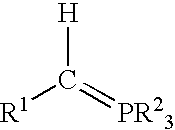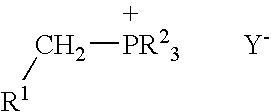Process for preparing functional group-containing olefinic compounds
a functional group and compound technology, applied in the field of functional group-containing olefinic compounds, can solve the problems of reducing the population of the next generation of larvae, affecting the production of tree fruits, vine and nut crops, and significant damage and economic loss in the production of various other crops, and achieving high yield of z high yield of e-configured functional group-containing olefins, and controlled stereo
- Summary
- Abstract
- Description
- Claims
- Application Information
AI Technical Summary
Benefits of technology
Problems solved by technology
Method used
Image
Examples
example 1
Preparation of Z / E-8-Dodecenyl Acetate (Pheromone of the Oriental Fruit Moth)
To a colourless suspension of n-butyltriphenylphosphonium bromide (1.75 g, 4.39 mmol) (prepared essentially according to the Preparation of Phosphonium Salts, except that n-butyl bromide and triphenylphosphine were used as the reactants, and anhydrous toluene was used as the reaction solvent; also available from Sigma-Aldrich Canada) in toluene (20 mL) in a 50 mL round bottom flask was added potassium tert-butoxide (544 mg, 4.85 mmol) at room temperature under Ar-atmosphere. The suspension turned intensely orange-red in colour. The mixture was stirred at room temperature for 1 hour, after which time the colour had not changed. 8-Bromooctan-1-al (1.37 g, 6.61 mmol) (prepared essentially as described in the Oxidation Protocol) was added dropwise via syringe. The colour changed to light yellow. A weak exotherm was observed. The reaction mixture was stirred at room temperature for 30 min. Saturated aqueous NH4C...
example 2
Preparation of Z / Z-11-Tetradecenyl Acetate (Pheromone of the Oblique-band d L afroller)
To a colourless suspension of n-propyltriphenylphosphonium bromide (1.41 g, 3.6 mmol) in toluene (20 mL) (prepared essentially according to the Preparation of Phosphonium Salts, except that n-propyl bromide and triphenylphosphine were used as the reactants, and anhydrous toluene was used as the reaction solvent; also available from Sigma-Aldrich Canada) in a 50 mL round bottom flask was added potassium tert-butoxide (451 mg, 4.0 mmol) at room temperature under Ar-atmosphere. The suspension turned intensely red in colour. The mixture was stirred at room temperature for 1 hour, after which time the colour had not changed. 11-Bromoundecan-1-al (1.0 g, 4.0 mmol) (prepared essentially according to the Oxidation Protocol, but with 11-bromoundecan-1-ol as the starting material) was added dropwise via syringe. The colour changed to light yellow. A weak exotherm was observed. The reaction mixture was stirr...
example 3
Preparation of 8,10-Dodecadienol (Pheromone of the Codling Moth)
To a colourless suspension of butenyltri(n-butyl)phosphonium bromide (1.48 g, 4.38 mmol) (prepared essentially according to the Preparation of Phosphonium Salts, except that butenyl bromide and tri(n-butyl)phosphine were used as the reactants) in toluene (20 mL) in a 50 mL round bottom flask was added n-butyllithium (2.5 M in hexanes, 1.95 mL, 4.88 mmol) at room temperature under Ar-atmosphere. The resulting yellow suspension was stirred for 1 hour at room temperature. 8-Bromooctan-1-al (1.0 g, 4.83 mmol) (prepared essentially as described in the Oxidation Protocol) was added dropwise via syringe. A weak exotherm was observed. The reaction mixture was stirred at room temperature for 30 min. Saturated aqueous NH4Cl (10 mL) and water (10 mL) were added. The aqueous phase was separated and extracted with heptane (2×20 mL). The resulting organic phase was washed with water (2×20 mL) and brine (20 mL), and dried (Na2SO4). Ev...
PUM
 Login to View More
Login to View More Abstract
Description
Claims
Application Information
 Login to View More
Login to View More - R&D
- Intellectual Property
- Life Sciences
- Materials
- Tech Scout
- Unparalleled Data Quality
- Higher Quality Content
- 60% Fewer Hallucinations
Browse by: Latest US Patents, China's latest patents, Technical Efficacy Thesaurus, Application Domain, Technology Topic, Popular Technical Reports.
© 2025 PatSnap. All rights reserved.Legal|Privacy policy|Modern Slavery Act Transparency Statement|Sitemap|About US| Contact US: help@patsnap.com



